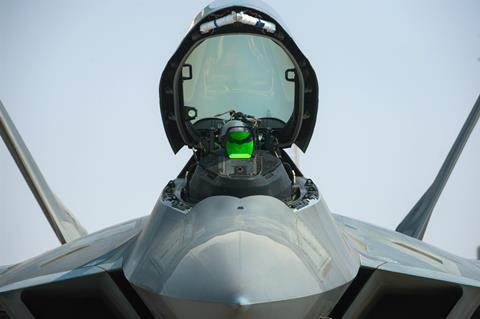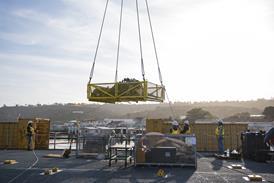Lockheed Martin’s vaunted F-22 air superiority fighter is set to receive a new passive threat-detection system meant to increase survivability.
The military airframer received a $270 million contract from the US Air Force on 22 January to upgrade the F-22 fleet with the company’s new Infrared Defensive System (IRDS).
Based on Lockheed’s existing Tactical Infrared Search and Track (TacIRST) system, the IRDS will use a distributed network of sensor heads, embedded in F-22 fuselages, to passively identify and track airborne objects via heat signature. Each sensor will be flush with the jet’s airframe, maintaining the aircraft’s critical stealthy profile.

This could be similar to the Distributed Aperture System carried by Lockheed F-35s. That system includes a network of fuselage-mounted cameras that allow pilots to virtually “see” through aircraft structures and view surrounding environments. The system can also detect and track incoming threats.
Notably, the infrared detection method used by the IRDS is not susceptible to jamming or disruption via electronic warfare, unlike active detection measures like radar.

“We understand the need for advanced and versatile infrared systems like IRDS that will make pilots’ missions more survivable and lethal against current and future adversaries,” says Hank Tucker, Lockheed’s vice-president of missions systems.
Lockheed unveiled the TacIRST system on which the F-22’s IRDS is based in 2022. The demonstrations saw two privately-operated Northrop F-5 fighters owned by adversary air provider Tactical Air Support fitted with nose-mounted TacIRST systems, rather than earlier podded sensors.
This configuration featured a fixed field of view, as opposed to the distributed aperture system being fielded on the F-22, which presumably will offer broader search angles.
Infrared detection capability has become increasingly important in recent years, as the USA’s dominance in the production of stealth aircraft has eroded. Geopolitical adversaries are producing and fielding low-observable fighters, including China’s Chengdu J-20 and Russia’s Sukhoi Su-57.
China in December 2024 unveiled two new designs about which little is known. Both appear to include low-observability features such internal weapons bays and sleek, blended fuselages and no vertical stabilisers.
Infrared detection systems may be key to identifying such aircraft, depending on the effectiveness of their stealth technology. Manufacturers are also pitching the sensors as a means of detecting small cruise missiles, which have featured prominently in the Russia-Ukraine war and recent hostilities near the Red Sea.
IRST systems have been available in podded form for several years, including a Lockheed-made system carried by Boeing F/A-18E/F Super Hornets, Boeing F-15Cs and Lockheed F-16s.
Adversary air provider Top Aces in 2024 fielded a Leonardo-made IRST sensor on its private fleet of F-16s – the only such fleet in the world.































